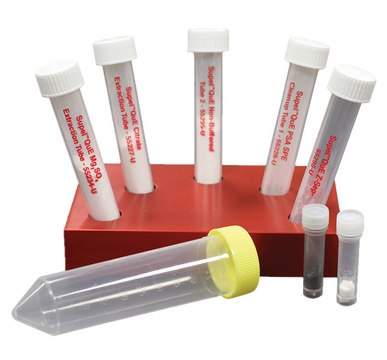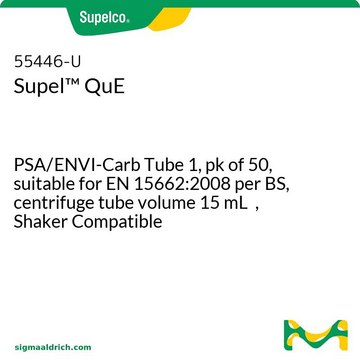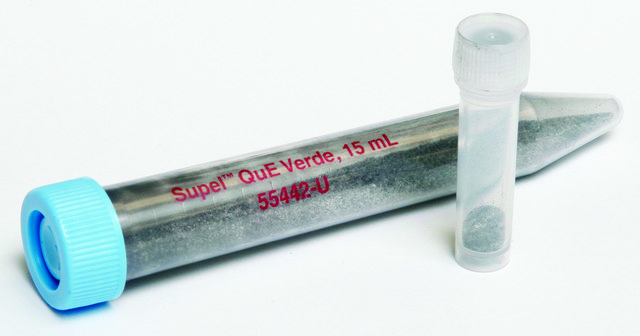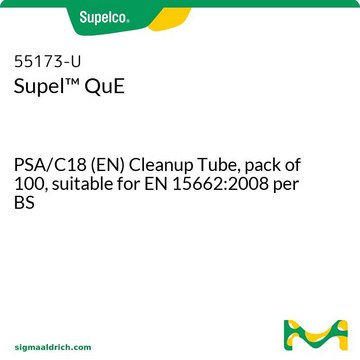Product Name
Supel™ QuE, Citrate Extraction Tube, pk of 50, suitable for EN 15662
material
polypropylene tube
Quality Level
Agency
suitable for EN 15662
제품 라인
Supel™
구성
magnesium sulfate, 4 g
sodium chloride, 1 g (Cat. No. S7653)
sodium citrate dibasic sesquihydrate, 0.5 g (Cat. No. 71635)
sodium citrate tribasic dihydrate, 1 g (Cat. No. S4641)
포장
pk of 50
기술
QuEChERS: suitable
원심분리 튜브 용적
15 mL
응용 분야
food and beverages
분리 기술
ion exchange
유사한 제품을 찾으십니까? 방문 제품 비교 안내
일반 설명
Dispersive SPE (dSPE), often referred to as the "QuEChERS" method (Quick, Easy, Cheap, Effective, Rugged, and Safe), is modern sample prep technique that is becoming increasingly popular in the area of multi-residue pesticide analysis in food and agricultural products.
Using the QuEChERS method, food/agricultural samples are first extracted with an aqueous miscible solvent (e.g., acetonitrile) in the presence of high amounts of salts (e.g., sodium chloride and magnesium sulfate) and/or buffering agents (e.g. citrate) to induce liquid phase separation and stabilize acid and base labile pesticides, respectively. Upon shaking and centrifugation, an aliquot of the organic phase is subjected to further cleanup using SPE. Unlike traditional methods using SPE tubes, in dispersive SPE, cleanup is facilitated by mixing bulk amounts of SPE (e.g., Supelclean PSA, ENVI-Carb, and/or Discovery DSC-18) with the extract. After sample cleanup, the mixture is centrifuged and the resulting supernatant can either be analyzed directly or can be subjected to minor further treatment before analysis.
Supelco carries a line of vials and centrifuge tubes containing pre-determined amounts of salts and SPE sorbents to support the most common method configurations used today.
Using the QuEChERS method, food/agricultural samples are first extracted with an aqueous miscible solvent (e.g., acetonitrile) in the presence of high amounts of salts (e.g., sodium chloride and magnesium sulfate) and/or buffering agents (e.g. citrate) to induce liquid phase separation and stabilize acid and base labile pesticides, respectively. Upon shaking and centrifugation, an aliquot of the organic phase is subjected to further cleanup using SPE. Unlike traditional methods using SPE tubes, in dispersive SPE, cleanup is facilitated by mixing bulk amounts of SPE (e.g., Supelclean PSA, ENVI-Carb, and/or Discovery DSC-18) with the extract. After sample cleanup, the mixture is centrifuged and the resulting supernatant can either be analyzed directly or can be subjected to minor further treatment before analysis.
Supelco carries a line of vials and centrifuge tubes containing pre-determined amounts of salts and SPE sorbents to support the most common method configurations used today.
애플리케이션
Supel™ QuE citrate tube is used for the determination of pesticide residues on vegetables using various analytical techniques.
적합성
Suitable for extracting ~10 g food/agricultural sample. The citrate is to buffer the extraction to pH 5.0 - 5.5. At this pH, most acid and base labile pesticides are stable.
법적 정보
Supel is a trademark of Sigma-Aldrich Co. LLC
애플리케이션
제품 번호
설명
가격
Storage Class Code
13 - Non Combustible Solids
WGK
WGK 1
Flash Point (°F)
Not applicable
Flash Point (°C)
Not applicable
이미 열람한 고객
자사의 과학자팀은 생명 과학, 재료 과학, 화학 합성, 크로마토그래피, 분석 및 기타 많은 영역을 포함한 모든 과학 분야에 경험이 있습니다..
고객지원팀으로 연락바랍니다.



